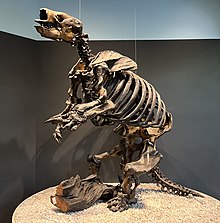| Paramylodon | |
|---|---|

| |
| Skeleton at the La Brea Tar Pits Museum | |
| Scientific classification | |
| Domain: | Eukaryota |
| Kingdom: | Animalia |
| Phylum: | Chordata |
| Class: | Mammalia |
| Order: | Pilosa |
| Family: | †Mylodontidae |
| Subfamily: | †Mylodontinae |
| Tribe: | †Mylodontini |
| Genus: | †Paramylodon Brown, 1903 |
| Type species | |
| †Paramylodon harlani (Owen, 1840)
| |
Paramylodon is an extinct genus of ground sloth of the family Mylodontidae endemic to North America during the Pliocene through Pleistocene epochs, living from around ~4.9 Mya–12,000 years ago.
Within the genus only two species are recognized: Paramylodon harlani, also known as Harlan's ground sloth known from Early Pleistocene to the Late Pleistocene (Irvingtonian-Rancholabrean) and the earlier Pliocene-Early Pleistocene (Blancan) species Paramylodon garbanii, though the placement of the latter in the genus has been questioned by some authors. The first fossil findings date back to the beginning of the 1830s. They go back to Richard Harlan, in whose honor the species was named. The genus Paramylodon was introduced by Barnum Brown in the early 20th century. Over 150 years after the description of the first species, the finds that are now attributed to Paramylodon were repeatedly placed in with other genera, first with Mylodon, but since the 1950s increasingly with Glossotherium. Paramylodon shares numerous features that suggest a close relationship with Glossotherium. Only since the 1990s have both genera been considered distinct, with Glossotherium restricted to South America, while Paramylodon inhabited North America.
The species Paramylodon harlani is known from remains found across North America, with abundant remains known from the La Brea tar pits in California.
Like some other mylodontids, Paramylodon had osteoderms embedded within its skin. Paramylodon lived in open landscapes, sometimes also in mountainous locations, and were grazers or mixed feeders. Preserved footprints are known. The morphology of the forelimbs has led to suggestions that Paramylodon may have engaged in burrowing.
Like other ground sloths, Paramylodon became extinct around 14-12,000 years ago as part of the Late Pleistocene megafauna extinctions of most large mammals across the Americas. Paramylodon overlapped in time with Paleoindians, the earliest human inhabitants of the Americas, who may have hunted Paramylodon. Its extinction may be the result of climatic change, hunting, or a combination of both factors.